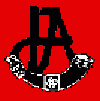The Protected Village Programme Rank Structure and Badges of Rank Honours, Awards Roll of Honour Picture Gallery Site Home Page
Uniforms Through the Twentieth Century

This illustration shows the uniform worn by the Matabeleland Native Police circa 1895. The tunic was fastened by five large brass buttons bearing the letters "MNP" (see below first button)Two small buttons fastened the epaulets.
Illustration A. J. Bundock
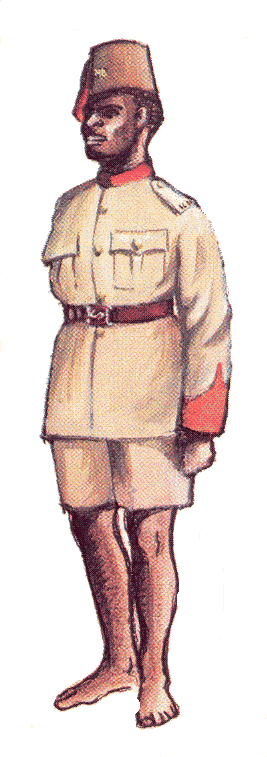
This second illustration shows the uniform worn by a Native Messenger of the Native Department in 1929.
The letters "ND" in brass were worn on the Fez and shoulder titles. Four large brass buttons embossed "ND" were worn down the tunic and smaller versions of the same buttons fastened the pockets andepaulets.
Illustration A. J. Bundock
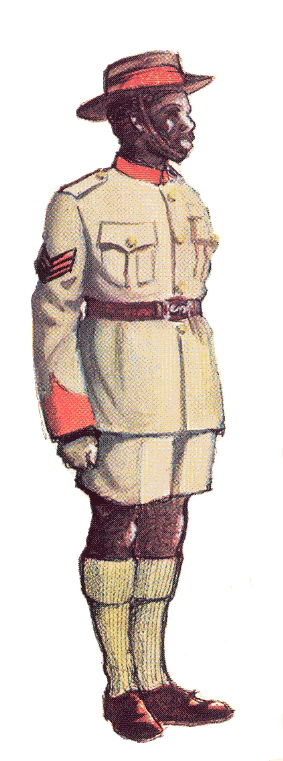
This illustration is of a Sergeant or Senior District Assistant wearing the full-dress uniform of the Ministry of Internal Affairs.
The pattern of the tunic is the same as that of 1929 and the same number of buttons were worn. Both the badge and buttons were of anodised metal. The badge worn on the turn-up of the bush hat is the Rhodesian Coat of Arms. the Same Coat of Arms is embossed on the buttons.(see third button at bottom)
Illustration A. J. Bundock
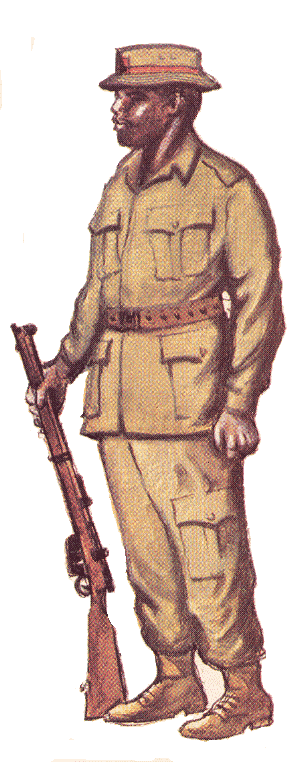
This illustration depicts a District Assistant in the new service dress Circa 1974. The new badge consists of an oliphant (a legendry war horn made from elephant tusk) surmounted by the letters "IA" for Internal Affairs. A cloth badge - black on red - is worn on the jungle hat, whilst a black metal badge on a red felt field is worn on the bush hat..
Once again the same number of buttons were worn and had the "New insignia" embossed on them. The tunic has been altered and has an open collar, whilst retaining the scarlet facings
The leather belt was later replaced by a stable belt of scarlet/khaki/scarlet. When worn with short trousers the stockings had scarlet tops.
Illustration A. J. Bundock

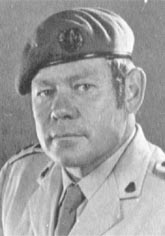
Illustrated above are the buttons of Matabeleland Native Police (1895), Native Department (1929), Ministry Of Internal Affairs (1964) and Internal Affairs (1974).
Illustrated to the left is DC Alex Bundock, who drew many of the illustrations used on this page.
REGIMENTAL UNIFORMS, ACCOUTREMENTS AND COLOURS
Stable Belt.
The stable
belt of Intaf was made of canvas and was
fastened by black leather straps and buckles which were positioned to
the wearers left. The colours of the stable belt were in three equal
strips in scarlet, khaki and scarlet.
Uniforms
and Badges.
MNP. The MNP did not wear headgear but did have
brass buttons on their blue tunic. The buttons were plain except for
the letters MNP. The uniform was completed by the wearing of khaki
shorts with a scarlet strip of cloth at the bottom of each leg.
The MNP were armed with Martini Henri rifles and ammunition
was carried in a brown leather bandolier. A brown leather belt with a
brass "snake clasp" was worn with the uniform.
Native
Department. The department was known as the
Native
Department during the late 1920s and in 1929 the uniform consisted of a
long sleeved khaki tunic with a scarlet high standing collar and
scarlet facings on the sleeves. Plain brass buttons with the letters ND
on them were worn on the tunic. The headgear consisted of a khaki fez
with a scarlet tassel and a badge consisting of the letters ND in brass
and later in staybright anodised aluminum was worn on the front. The
same badge was also worn on the tunic as a shoulder title. The belt
remained the same as the MNP.
Intaf.
The uniform jacket, belt and shorts of the Native Department remained
as a stepping out uniform with the addition of khaki stockings and
brown leather shoes. In the early 1960s the headgear changed and a
khaki slouch hat with a scarlet puggree was adopted. The Southern
Rhodesian Coat of Arms in anodised aluminium was worn as a hat badge on
the upturned left side of the slouch hat. During the days of the
Federation the Federal Coat of Arms was worn as a badge.
Military style NCOs rank chevrons (red on black background) were adopted to indicate rank. Field uniform was exactly the same except that a khaki shirt was worn instead of the jacket.
As the war in Rhodesia developed and the role of Intaf changed, a new combat uniform was introduced for wear by all members. It consisted of a green/khaki long sleeved combat jacket and trousers of the same colour worn with a web belt on the outside. This uniform was reminiscent of the uniform worn by the Rhodesian and British army in the 1950s and 1960s. Standard brown combat boots and a jungle hat with a scarlet hat band completed the uniform. Webbing was issued for combat situations and was standard for the Security Forces of the time. A khaki shirt was worn as an alternative to the jacket in hot weather.
Eventually camouflage uniforms were issued. The same pattern camouflage was worn by all arms of the service and shoulder titles were worn to designate each arm of service. A cherry red beret was adopted in keeping with the colours of Intaf and a new cap badge was introduced. It was in black metal and consisted of the letters IA surmounted on an oliphant. The oliphant was a legendary war horn made from an elephant tusk. The badge was worn by itself on the beret and with a red felt background on the slouch hat.
At about the same time a similar cap badge was made in black embroidered thread on a red square background and was worn on the jungle hat. Some members took to sewing in onto the slouch hat instead of wearing the metal badge.
Training Wing
The Training Wing at
Chikarubi wore a cloth patch on the left arm. It was black printed on
khaki/green and consisted of the motto - Moyo we Shumba (heart of a
lion) above a lion facing left with an upturned spear in one paw.
Underneath were the words Training Wing, a laurel wreath and at the
bottom, Internal Affairs.
Mounted
Troops
The mounted troops wore a khaki cloth badge
with a red printed horse on its hind legs facing right. The letters IA
were on the left and the letters MU on the right of the horse. The
badge was worn on the left sleeve.
Administration
Reinforcement Units
The ARUs all
wore the Intaf cap badge and each Troop, except for one, had their own
cloth shoulder badge. Most shoulder badges were black printed on khaki
and consisted of the Provincial title on top of an emblem and the
letters ARU underneath surrounded by a border. However G Troop in
Matabeleland North did not appear to have a badge. The ARU's wore the
standard Intaf uniforms to begin with. Several members wore an army
camouflage combat jacket instead of the Intaf khaki issue. Shortly
after, all ARUs were issued with standard camouflage kit in keeping
with all arms of service. The DC of Mudzi district formed a special
reaction unit and the members of this team wore a chest title, black
printed on green with the letters MRU. This was an unofficial badge.
